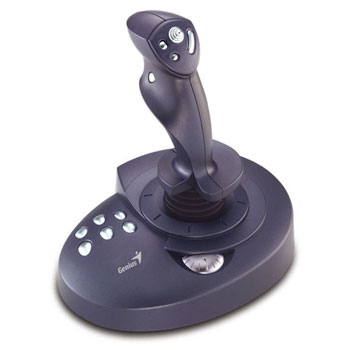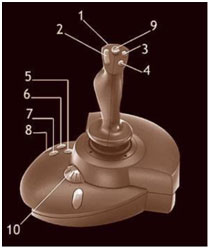If you have ever visited a video game parlour to play a video game, you definitely would have used a JOYSTICK. Originally invented for flight controllers and motion simulators, they gained acceptance in number of systems, ranging from video games to industrial systems.
Fig. 1: A Representational Image of a Joystick
Millions of video game enthusiasts, crane operators, etc. would owe a debt of gratitude to the inventor of this wonderful device, a joystick, though the inventor of this device is not quite known.
The word ‘Joystick’ was used first by Robert Loraine and was cited in the Oxford English Dictionary, though he didn’t invent the device. Mr. Robert Esnault – Pelterie is also mentioned to be an originator of this buzz word. A E George along with Jobling used a stick for the first time when they flew an aircraft and this stick gained popularity as Joystick. But whatever may be the origin, joystick has been one of the significant achievements of the 20th century though it hasn’t got that much credit.
Three virtues of this device are simplicity, efficiency, and control. The intuitive nature of the joystick has made it a natural option for precision control applications, such as camera control. Joystick manufacturers have extended its basic functionality to create a range of specialized products, adapting everything from core materials to appearance in order to meet the special requirements for each application.
Earlier computers used to have a joystick port. These ports were designed to read analog joystick. But nowadays, due to the wide popularity of USB ports, joysticks are available with USB interfaces. Analog joysticks are less common nowadays and also, available at very low costs.
WHAT IS A JOYSTICK?
Joysticks are devices which translate entirely physical movement, i.e., the movement of your hand into electrical signals which are finally converted into entirely mathematical (a binary string of 1’s and 0’s) by computational units. The joystick simply translates the movement of a stick into electronic information which computing systems can process.
Joystick is an input device consisting of a stick and some buttons; the stick is pivoted to the base. Movement of the stick (also called handle) varies its angle and direction with respect to the base. The angle and direction is sensed and used to take appropriate control actions.

Fig. 2: A Figure Showing a Typical Configuration of a Joystick
Joysticks may be one-dimensional, two-dimensional and three-dimensional but most of them are two-dimensional. Typical configuration of a joystick is as follows: moving the stick left or right is treated as movement along X-axis, moving the stick up or down is treated as movement along Y-axis, twisting the stick clockwise or anti-clockwise is treated as movement along Z-axis. Thus, a single, convenient and hand movable device can be used for roll, pitch and yaw movement of the aircraft or pan, tilt and zoom for the cameras. In additions, joysticks have some buttons which can be used to trigger/fire an event.

Fig. 3: A Diagram Representing Typical Buttons in a Joystick
Joystick essentially consists of a rod which is fitted with a handle. Tilting the stick forward and backward pivots the Y-axis shaft from side to side. Tilting it left to right pivots the X-axis shaft. When you move the stick diagonally, it pivots both shafts.
Joysticks may be analog or digital; analog joysticks have continuous states whereas digital joysticks give just ON/OFF signals for different directions.
Digital joystick closes the “forward switch” or “backward switch” when moved forward and closes the “left switch” or “right switch” when moving sideways and so on. Systems can be made to sense diagonal movements and so on. In a similar fashion, the buttons work, i.e., when pressed, the switch is closed. Thus a digital joystick processes movements as absolute values instead of subtle values.
On the contrary, analog joysticks can sense a full range of motion of the joystick. For each axis of the joystick movement (x and y), there is a potentiometer. The output of each potentiometer is fed to RC circuit. If the resistance is more, the capacitor will take longer to charge; if resistance is less, the capacitor will charge quickly. Discharging the capacitor and then determining how long it takes to recharge allows value of the potentiometer or the position of the joystick to be computed. The measured recharge rate is a numerical value the computer can recognize. Since position of joystick on each axis is known, it enables computation of the exact position of the joystick
The switch outputs are normally open and are treated as digital inputs. The switches will return TRUE if they are pressed else they will return FALSE.
Joystick applications demand reliability, durability as well as quality. Joysticks are employed as an input device and are expected to match the sophistication of the underlying control software.
By reading the position of the joystick and the status of the switches of joystick, various actions can be taken.
Important Aspects of a Joystick
IMPORTANT ASPECTS OF A JOYSTICK
• Ergonomic features
The joystick acts as the primary interface between the user and the system. It presents one of the most significant physical attributes of a system as well as the appearance of the system. It conveys a strong impression of the quality of the system. It has been shown that a system with nice interface is treated as a fine piece of equipment, and enhances the product’s image in the mind of the customer.
• Functions
A joystick typically has three types of motion controls — forward and back, side-to-side, and in/out. In the context of camera applications, these movements are referred to as pan, tilt and zoom controls. In addition, the fingertip control offers wide range of controls through the most natural and convenient motion of the hand.
Pan and tilt motions can be guided or unconstrained as per the application requirements. The guided option allows the motion to be gently biased toward the cardinal directions (North, South, East and West). It is possible to move the handle away from the poles using slightly greater force. The third dimension – forward and back in mechanical applications and zoom control in cameras – is accomplished by twisting the handle
• Handle
Proper handle is not just a question of how the unit looks but also how it will be used. Using a smaller handle requires the user to grip the joystick with just the forefinger and thumb. This provides the finest control, and at the same time, limits the amount of force a user can exert in comparison to a large handle, which can be gripped with the whole hand.
• Interface Circuitry
Interface circuitry is needed to translate the user’s motion into electrical signals. These electrical signals, in turn, are read by the device control software.
With early analog joysticks, joystick movements were typically sensed by a potentiometer, a variable resistor in which a sliding wiper blade moves across a fixed contact, mirroring changes in position of the joystick. Usual concern with the potentiometer based systems was the wear and corrosions due to the sliding component.
Modern joysticks use contactless technology, through which a field is generated within the joystick at the base of the shaft. As the shaft moves, the sensing part of the circuit detects the change in the field and outputs an analog voltage proportional to the distance moved. Friction and wear are eliminated, and the result is a joystick that can perform up to 5 million cycles without failure.
There are several options for how the joystick transmits position data to the main system. The best joysticks support multiple configurations, starting with standard, orthogonal signals, such as those produced by potentiometer-based systems, and ranging to schemes for mixing signals, such as for operating two motors.
• Durability
One of the important specifications of a joystick is the durability. If the joystick breaks, the entire product is effectively broken.
Inherently, contactless systems are longer-lasting. Also, use of metal components, especially at critical points such as end stops and Z-axis mechanism, enhances durability.
Protection against dust, oil and liquids is also provided using neoprene sealing boot.
• Reliability
Contactless joysticks offer better reliability as compared to potentiometer-based joysticks. Due to continual wear and friction, the potentiometer-based systems gradually drift and their performance degrades over time. Contactless systems are immune to mechanical wear.
• Fault-tolerance
For safety, fault-tolerance capability is desirable especially for critical systems. On failure, the joystick must know that a fault condition exists. For this, a redundant ’mirror’ signal is used which is compared with the main signal. If a difference is detected, the units send a special signal, allowing it to “return to center,” or whichever action is most appropriate.
Modern Joysticks
MODERN JOYSTICKS
Newer joysticks employ optical sensors instead of potentiometers to read the value of the joystick. In these joysticks, make-break beam sensing is employed. A pair of LED and photocell is used. When the joystick moves, the moving slots repeatedly break the light beam shining on the photocell. Based on the number of pulses that have got generated, the processor knows how far the stick has moved.
By monitoring the patterns from the photocells on both the axis, it is possible to figure out the movement of a joystick.
One of the significant additions to the joysticks world is force feedback technology. Force feedback joystick is to move the stick in conjunction with onscreen action. While shooting a gun in an action game, the stick would vibrate in your hands. Similarly, if plane is crashed in a flight simulator, the stick would push back suddenly. Force feedback joysticks have most of the same components as ordinary joysticks, with a few important additions — an onboard microprocessor, electrical motors and a gear train / belt system.
MANUFACTURERS/SUPPLIERS
Some of the major suppliers for Joysticks are:
• DeltaTech Controls
• Penny and Giles Controls
• Apem
• Genge & Thoma AG
• Printed Motor Works
• CTI Electronics
• OEM Controls
Advantages & Applications
ADVANTAGES
• Ease of use
• Simplification of the command control station
• Long service life
• Robust and lasting construction
APPLICATION
Joysticks have gained wide acceptance as the input user interface for number of industrial and other control systems. Some of the systems using joysticks are
• Aircrafts, UAVs for flight control
• Motorized Wheelchairs as input device
• Microscopes
• Industrial/Construction Equipments for controlling machines such as cranes, trucks, lawn mowers, assembly lines, forestry equipment, and excavators.
• Submarines
• Security Systems: For providing the flexibility and precision needed for camera pan tilt and zoom control to enable focus their attention on video images in order to respond quickly and easily to security issues.
• Video Games: Joysticks are widely used for video games
Filed Under: Articles


Questions related to this article?
👉Ask and discuss on Electro-Tech-Online.com and EDAboard.com forums.
Tell Us What You Think!!
You must be logged in to post a comment.